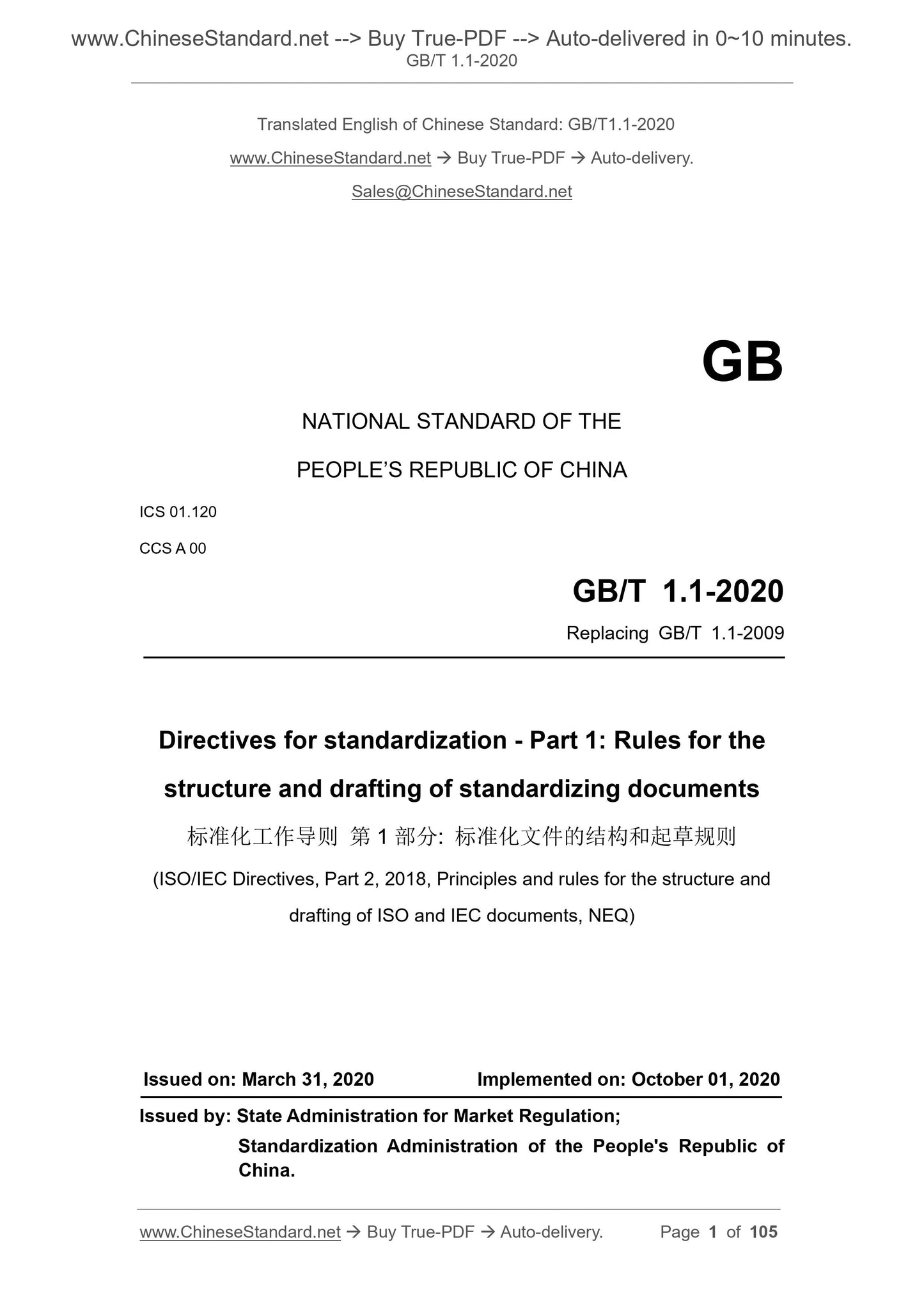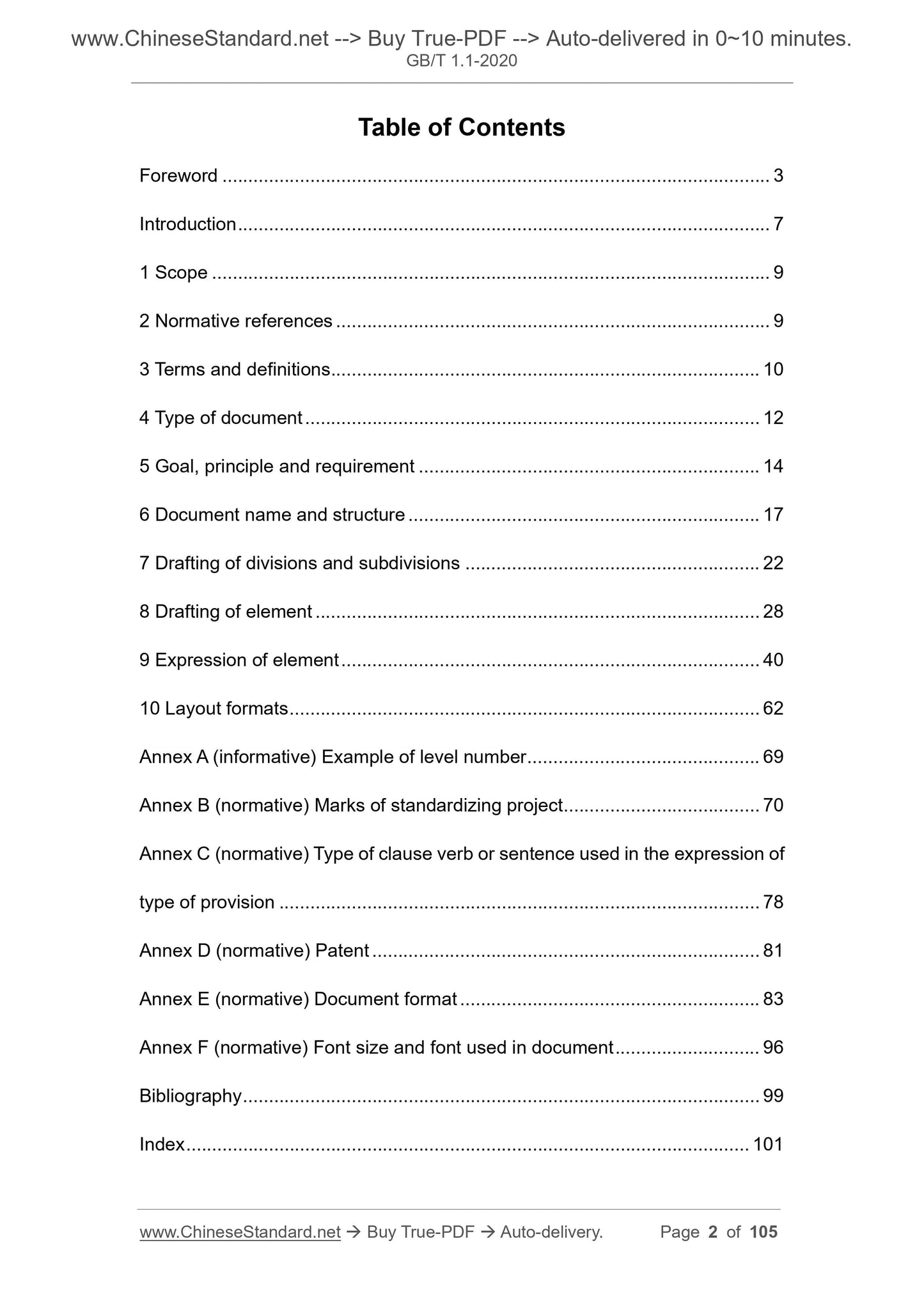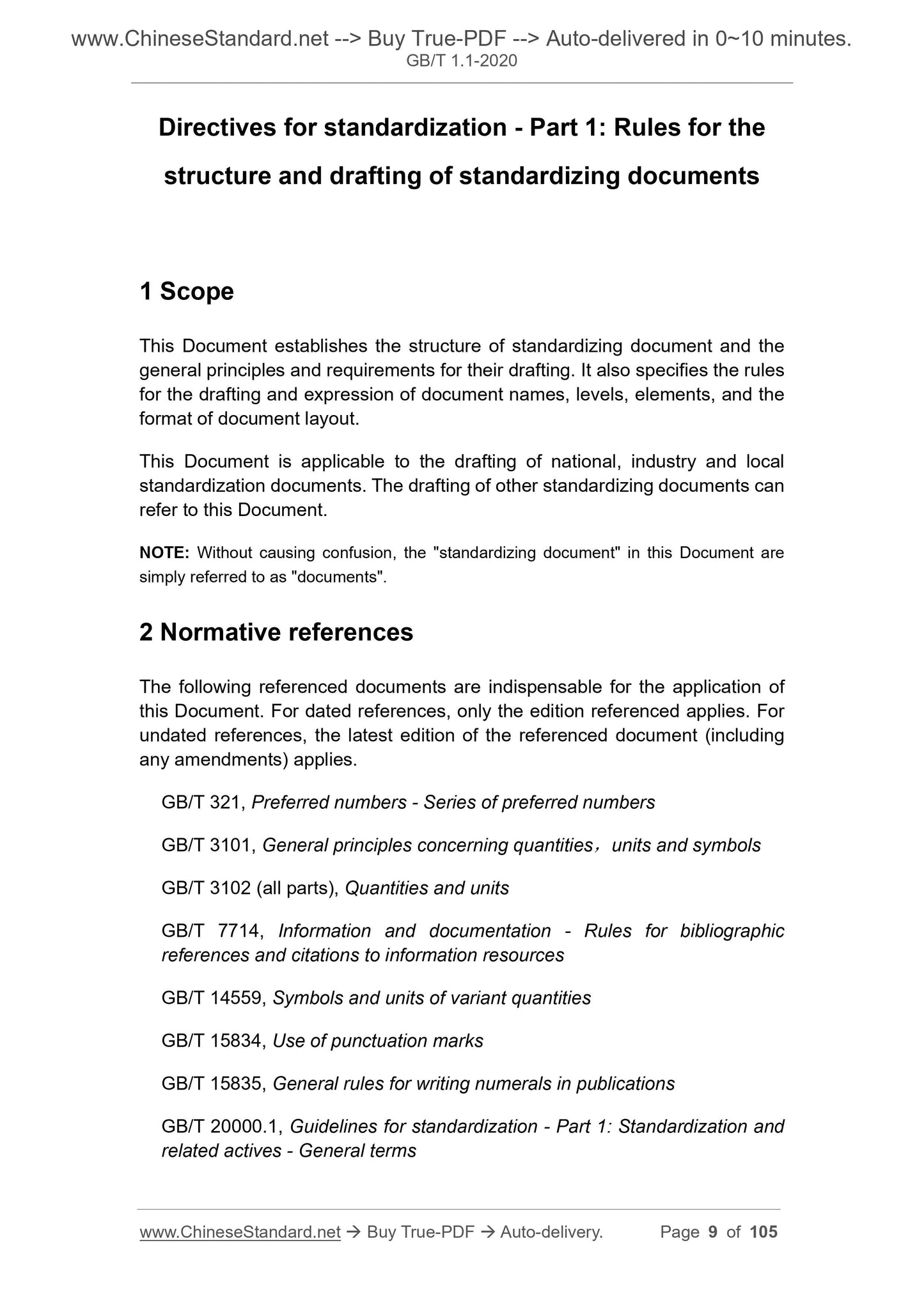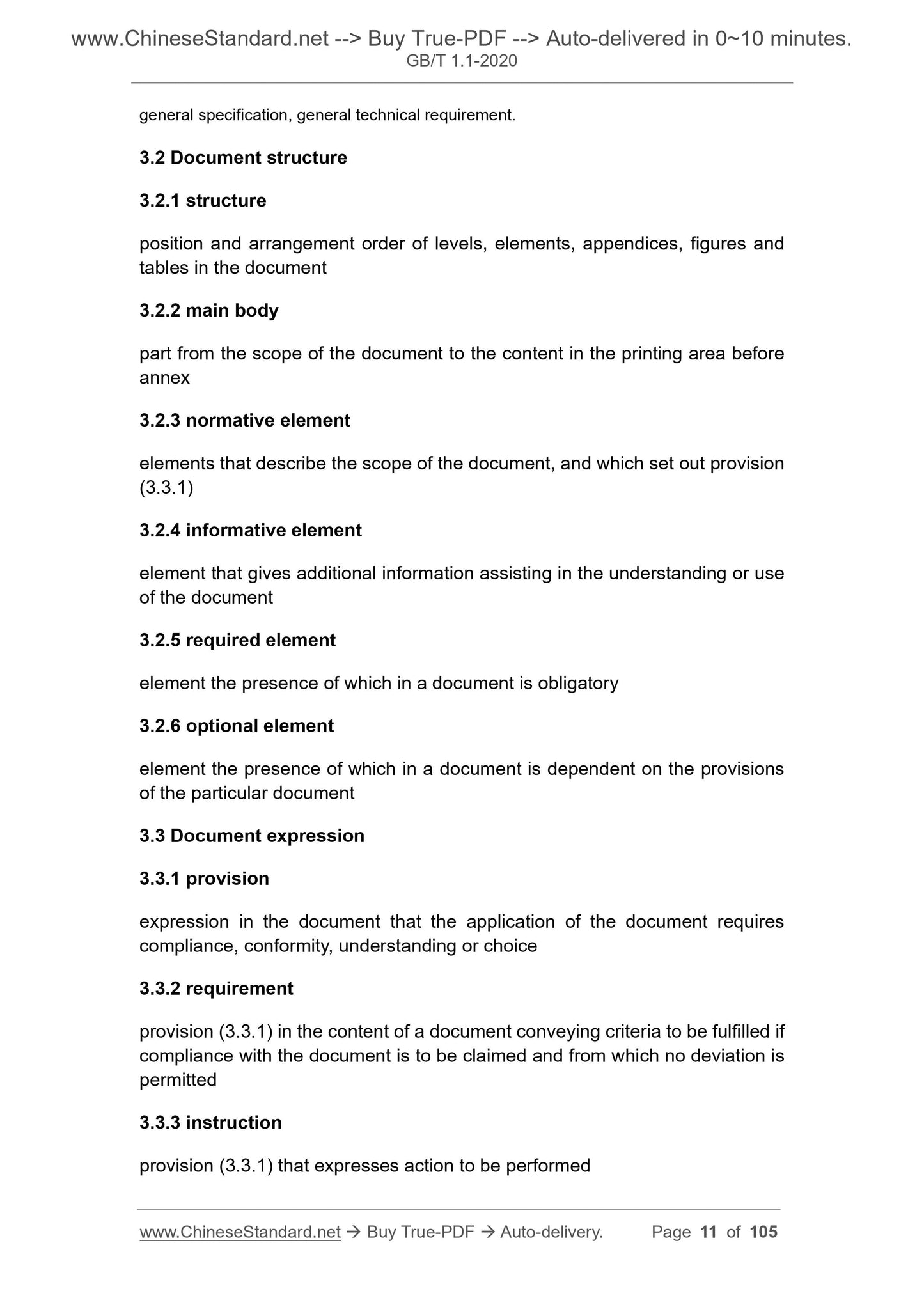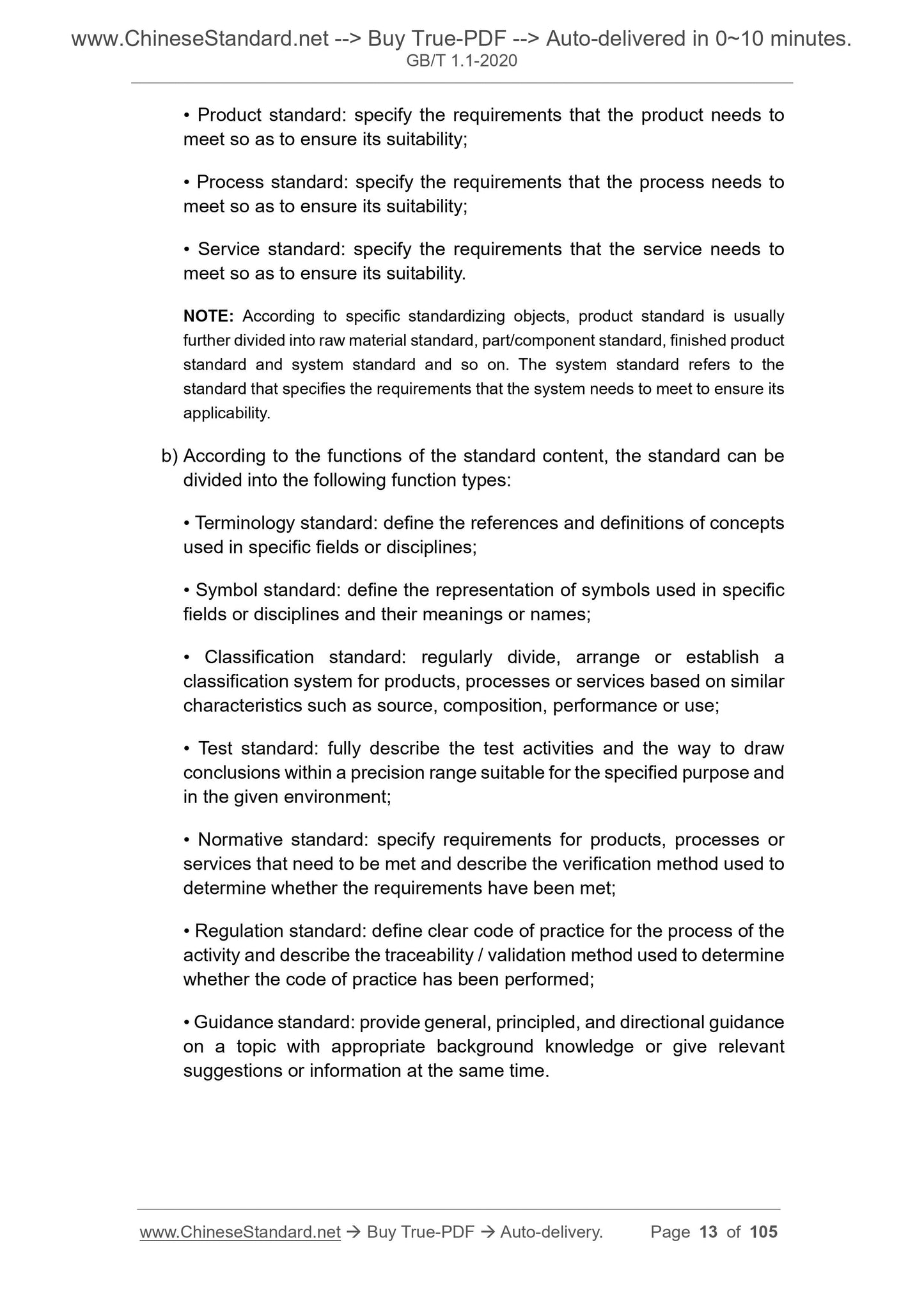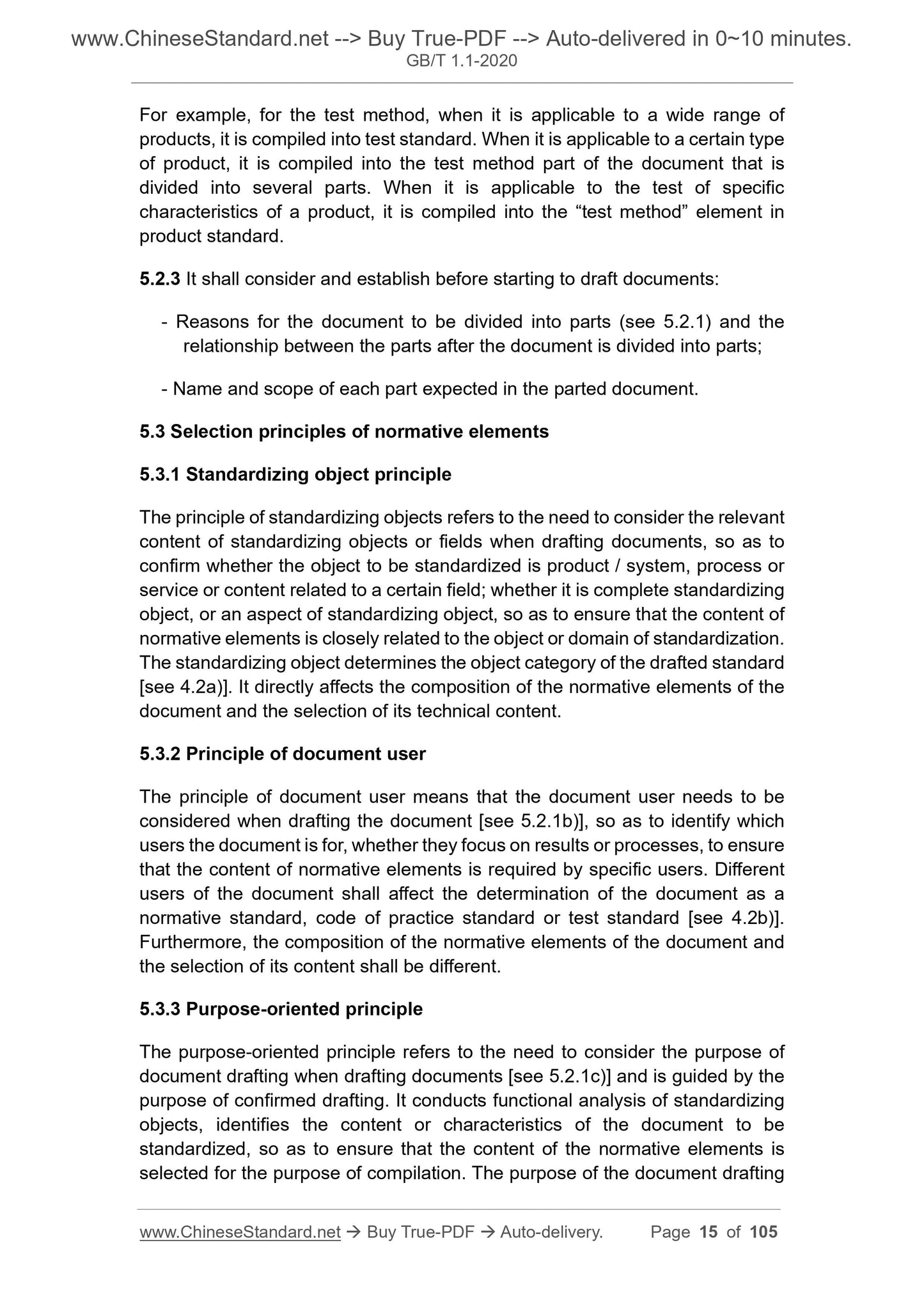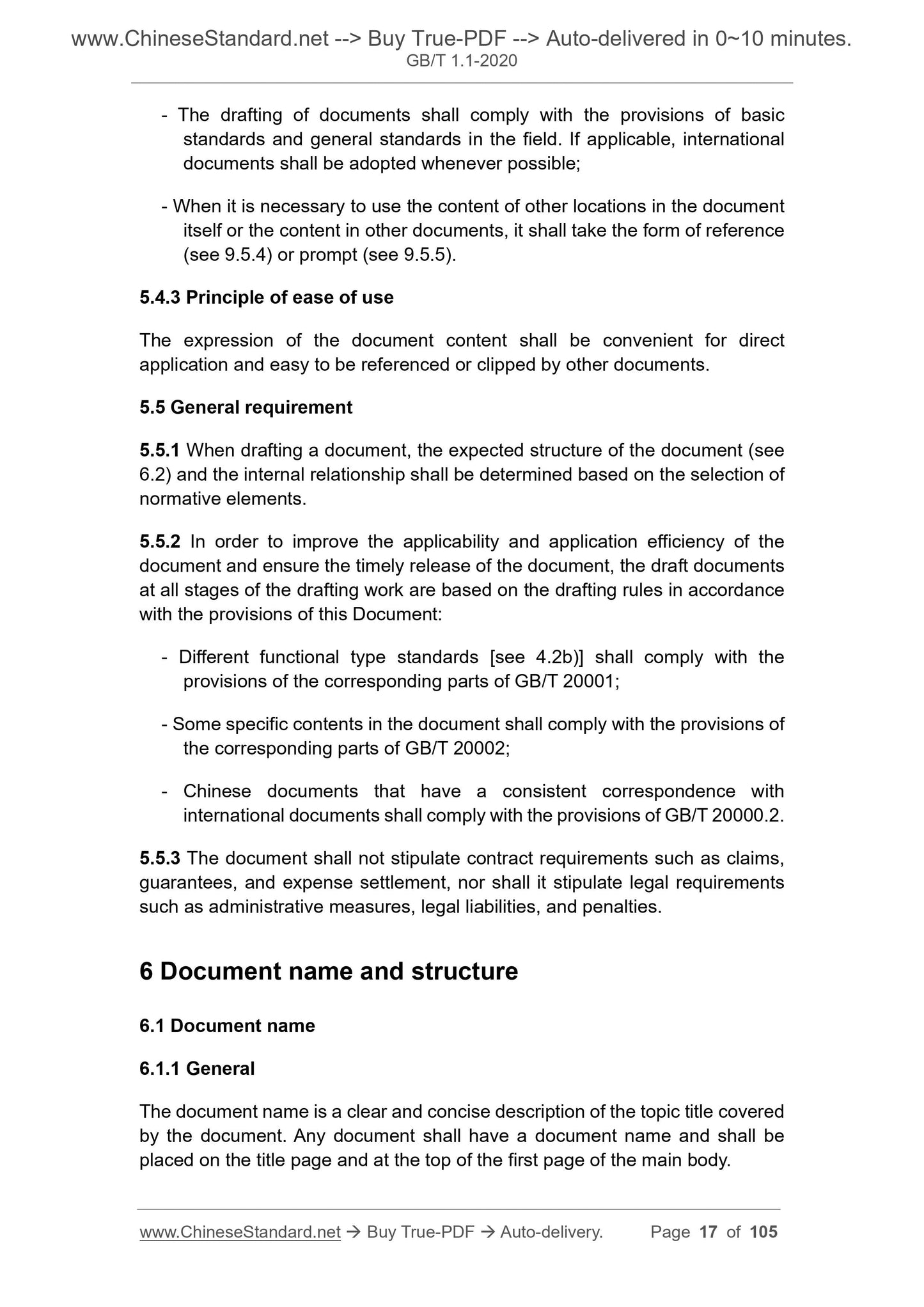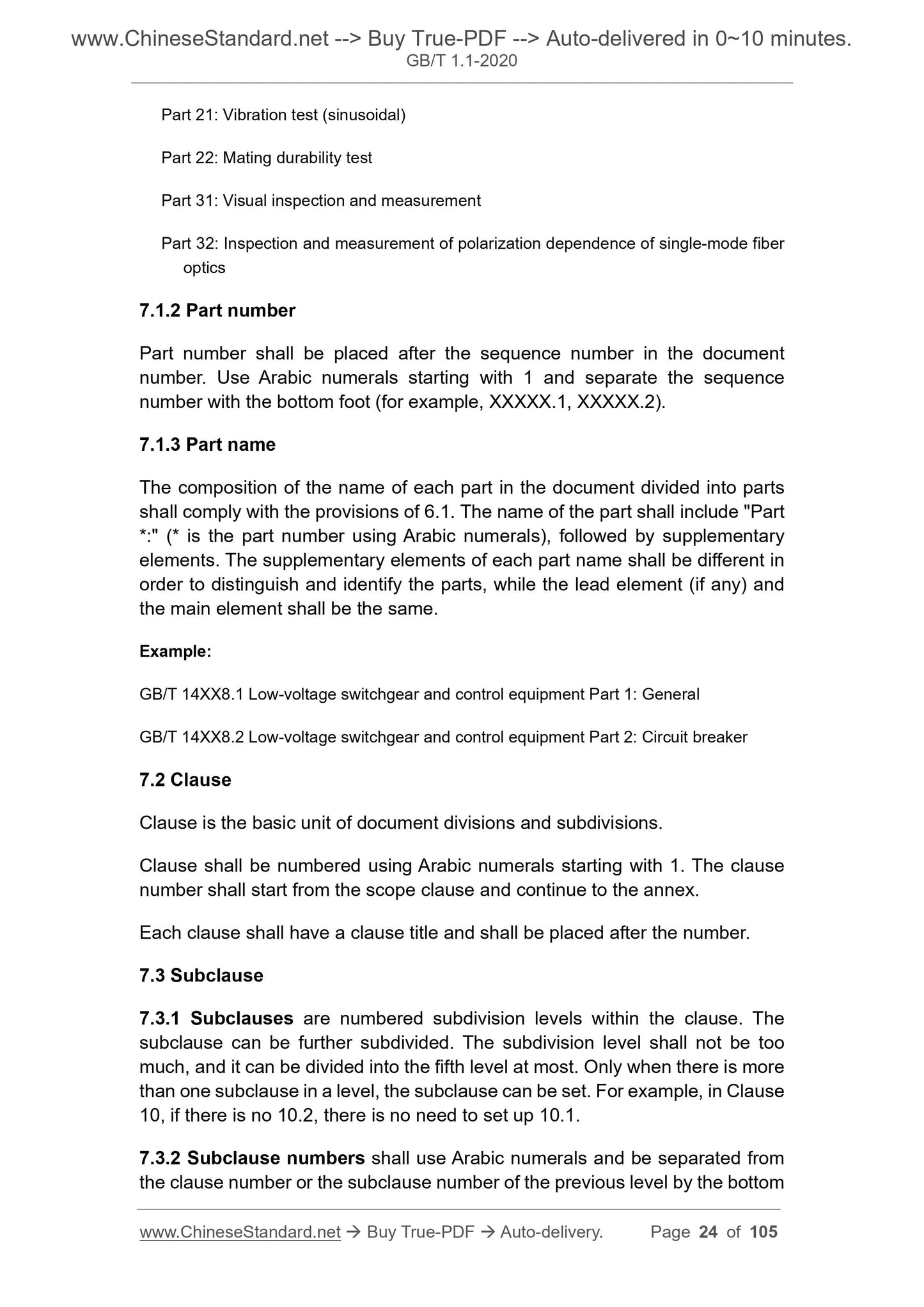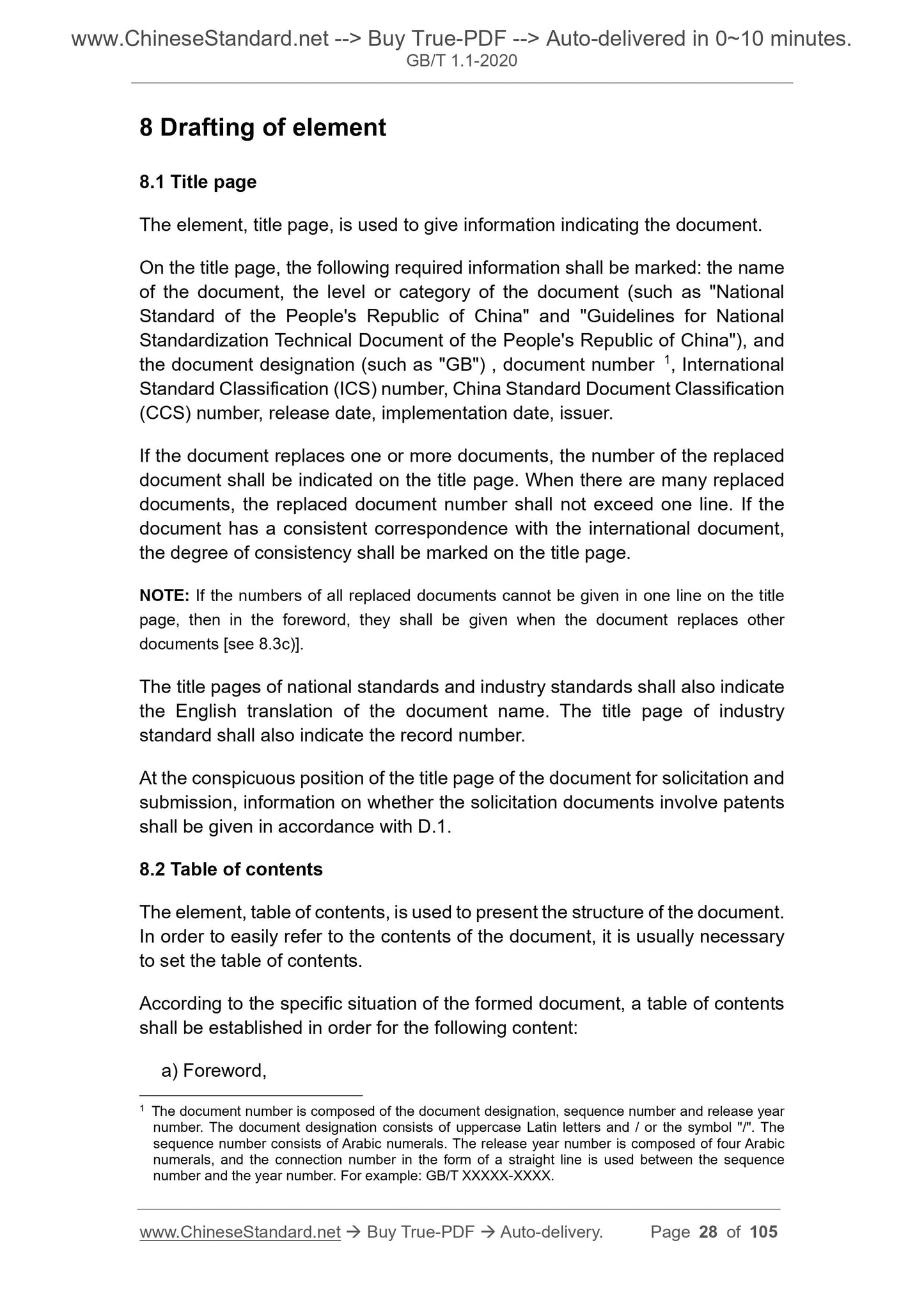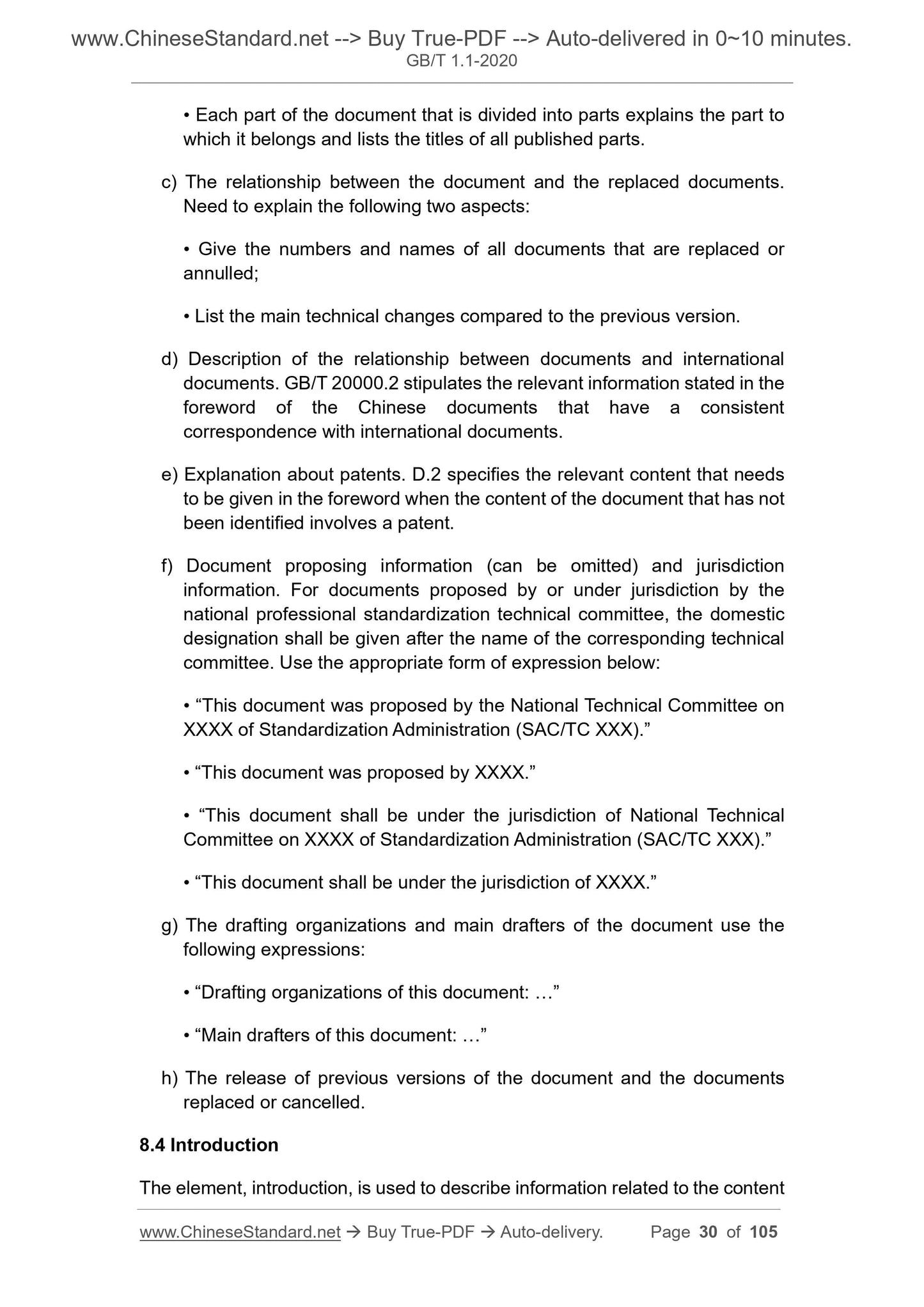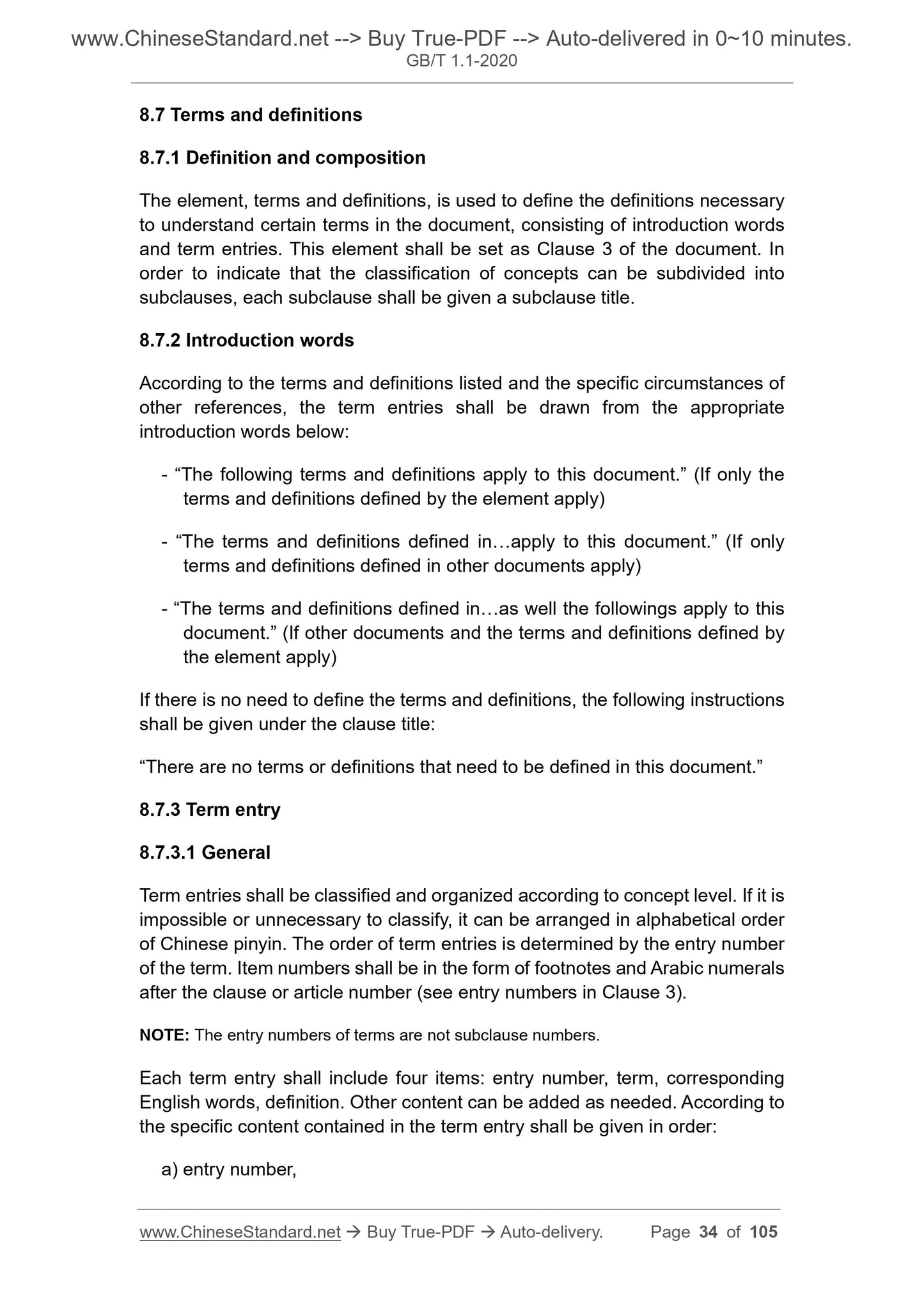1
/
of
12
PayPal, credit cards. Download editable-PDF and invoice in 1 second!
GB/T 1.1-2020 English PDF (GBT1.1-2020)
GB/T 1.1-2020 English PDF (GBT1.1-2020)
Regular price
$655.00 USD
Regular price
Sale price
$655.00 USD
Unit price
/
per
Shipping calculated at checkout.
Couldn't load pickup availability
Delivery: 3 seconds. Download true-PDF + Invoice.
Get QUOTATION in 1-minute: Click GB/T 1.1-2020
Historical versions: GB/T 1.1-2020
Preview True-PDF (Reload/Scroll if blank)
GB/T 1.1-2020: Directives for standardization -- Part 1: Rules for the structure and drafting of standardizing documents
GB/T 1.1-2020
NATIONAL STANDARD OF THE
PEOPLE’S REPUBLIC OF CHINA
ICS 01.120
CCS A 00
Replacing GB/T 1.1-2009
Directives for standardization - Part 1: Rules for the
structure and drafting of standardizing documents
(ISO/IEC Directives, Part 2, 2018, Principles and rules for the structure and
drafting of ISO and IEC documents, NEQ)
ISSUED ON: MARCH 31, 2020
IMPLEMENTED ON: OCTOBER 01, 2020
Issued by: State Administration for Market Regulation;
Standardization Administration of the People's Republic of
China.
Table of Contents
Foreword ... 3
Introduction ... 7
1 Scope ... 9
2 Normative references ... 9
3 Terms and definitions ... 10
4 Type of document ... 12
5 Goal, principle and requirement ... 14
6 Document name and structure ... 17
7 Drafting of divisions and subdivisions ... 22
8 Drafting of element ... 28
9 Expression of element ... 40
10 Layout formats ... 62
Annex A (informative) Example of level number ... 69
Annex B (normative) Marks of standardizing project ... 70
Annex C (normative) Type of clause verb or sentence used in the expression of
type of provision ... 78
Annex D (normative) Patent ... 81
Annex E (normative) Document format ... 83
Annex F (normative) Font size and font used in document ... 96
Bibliography ... 99
Index ... 101
Directives for standardization - Part 1: Rules for the
structure and drafting of standardizing documents
1 Scope
This Document establishes the structure of standardizing document and the
general principles and requirements for their drafting. It also specifies the rules
for the drafting and expression of document names, levels, elements, and the
format of document layout.
This Document is applicable to the drafting of national, industry and local
standardization documents. The drafting of other standardizing documents can
refer to this Document.
NOTE: Without causing confusion, the "standardizing document" in this Document are
simply referred to as "documents".
2 Normative references
The following referenced documents are indispensable for the application of
this Document. For dated references, only the edition referenced applies. For
undated references, the latest edition of the referenced document (including
any amendments) applies.
GB/T 321, Preferred numbers - Series of preferred numbers
GB/T 3101, General principles concerning quantities, units and symbols
GB/T 3102 (all parts), Quantities and units
GB/T 7714, Information and documentation - Rules for bibliographic
references and citations to information resources
GB/T 14559, Symbols and units of variant quantities
GB/T 15834, Use of punctuation marks
GB/T 15835, General rules for writing numerals in publications
GB/T 20000.1, Guidelines for standardization - Part 1: Standardization and
related actives - General terms
general specification, general technical requirement.
3.2 Document structure
3.2.1 structure
position and arrangement order of levels, elements, appendices, figures and
tables in the document
3.2.2 main body
part from the scope of the document to the content in the printing area before
annex
3.2.3 normative element
elements that describe the scope of the document, and which set out provision
(3.3.1)
3.2.4 informative element
element that gives additional information assisting in the understanding or use
of the document
3.2.5 required element
element the presence of which in a document is obligatory
3.2.6 optional element
element the presence of which in a document is dependent on the provisions
of the particular document
3.3 Document expression
3.3.1 provision
expression in the document that the application of the document requires
compliance, conformity, understanding or choice
3.3.2 requirement
provision (3.3.1) in the content of a document conveying criteria to be fulfilled if
compliance with the document is to be claimed and from which no deviation is
permitted
3.3.3 instruction
provision (3.3.1) that expresses action to be performed
• Product standard: specify the requirements that the product needs to
meet so as to ensure its suitability;
• Process standard: specify the requirements that the process needs to
meet so as to ensure its suitability;
• Service standard: specify the requirements that the service needs to
meet so as to ensure its suitability.
NOTE: According to specific standardizing objects, product standard is usually
further divided into raw material standard, part/component standard, finished product
standard and system standard and so on. The system standard refers to the
standard that specifies the requirements that the system needs to meet to ensure its
applicability.
b) According to the functions of the standard content, the standard can be
divided into the following function types:
• Terminology standard: define the references and definitions of concepts
used in specific fields or disciplines;
• Symbol standard: define the representation of symbols used in specific
fields or disciplines and their meanings or names;
• Classification standard: regularly divide, arrange or establish a
classification system for products, processes or services based on similar
characteristics such as source, composition, performance or use;
• Test standard: fully describe the test activities and the way to draw
conclusions within a precision range suitable for the specified purpose and
in the given environment;
• Normative standard: specify requirements for products, processes or
services that need to be met and describe the verification method used to
determine whether the requirements have been met;
• Regulation standard: define clear code of practice for the process of the
activity and describe the traceability / validation method used to determine
whether the code of practice has been performed;
• Guidance standard: provide general, principled, and directional guidance
on a topic with appropriate background knowledge or give relevant
suggestions or information at the same time.
For example, for the test method, when it is applicable to a wide range of
products, it is compiled into test standard. When it is applicable to a certain type
of product, it is compiled into the test method part of the document that is
divided into several parts. When it is applicable to the test of specific
characteristics of a product, it is compiled into the “test method” element in
product standard.
5.2.3 It shall consider and establish before starting to draft documents:
- Reasons for the document to be divided into parts (see 5.2.1) and the
relationship between the parts after the document is divided into parts;
- Name and scope of each part expected in the parted document.
5.3 Selection principles of normative elements
5.3.1 Standardizing object principle
The principle of standardizing objects refers to the need to consider the relevant
content of standardizing objects or fields when drafting documents, so as to
confirm whether the object to be standardized is product / system, process or
service or content related to a certain field; whether it is complete standardizing
object, or an aspect of standardizing object, so as to ensure that the content of
normative elements is closely related to the object or domain of standardization.
The standardizing object determines the object category of the drafted standard
[see 4.2a)]. It ...
Get QUOTATION in 1-minute: Click GB/T 1.1-2020
Historical versions: GB/T 1.1-2020
Preview True-PDF (Reload/Scroll if blank)
GB/T 1.1-2020: Directives for standardization -- Part 1: Rules for the structure and drafting of standardizing documents
GB/T 1.1-2020
NATIONAL STANDARD OF THE
PEOPLE’S REPUBLIC OF CHINA
ICS 01.120
CCS A 00
Replacing GB/T 1.1-2009
Directives for standardization - Part 1: Rules for the
structure and drafting of standardizing documents
(ISO/IEC Directives, Part 2, 2018, Principles and rules for the structure and
drafting of ISO and IEC documents, NEQ)
ISSUED ON: MARCH 31, 2020
IMPLEMENTED ON: OCTOBER 01, 2020
Issued by: State Administration for Market Regulation;
Standardization Administration of the People's Republic of
China.
Table of Contents
Foreword ... 3
Introduction ... 7
1 Scope ... 9
2 Normative references ... 9
3 Terms and definitions ... 10
4 Type of document ... 12
5 Goal, principle and requirement ... 14
6 Document name and structure ... 17
7 Drafting of divisions and subdivisions ... 22
8 Drafting of element ... 28
9 Expression of element ... 40
10 Layout formats ... 62
Annex A (informative) Example of level number ... 69
Annex B (normative) Marks of standardizing project ... 70
Annex C (normative) Type of clause verb or sentence used in the expression of
type of provision ... 78
Annex D (normative) Patent ... 81
Annex E (normative) Document format ... 83
Annex F (normative) Font size and font used in document ... 96
Bibliography ... 99
Index ... 101
Directives for standardization - Part 1: Rules for the
structure and drafting of standardizing documents
1 Scope
This Document establishes the structure of standardizing document and the
general principles and requirements for their drafting. It also specifies the rules
for the drafting and expression of document names, levels, elements, and the
format of document layout.
This Document is applicable to the drafting of national, industry and local
standardization documents. The drafting of other standardizing documents can
refer to this Document.
NOTE: Without causing confusion, the "standardizing document" in this Document are
simply referred to as "documents".
2 Normative references
The following referenced documents are indispensable for the application of
this Document. For dated references, only the edition referenced applies. For
undated references, the latest edition of the referenced document (including
any amendments) applies.
GB/T 321, Preferred numbers - Series of preferred numbers
GB/T 3101, General principles concerning quantities, units and symbols
GB/T 3102 (all parts), Quantities and units
GB/T 7714, Information and documentation - Rules for bibliographic
references and citations to information resources
GB/T 14559, Symbols and units of variant quantities
GB/T 15834, Use of punctuation marks
GB/T 15835, General rules for writing numerals in publications
GB/T 20000.1, Guidelines for standardization - Part 1: Standardization and
related actives - General terms
general specification, general technical requirement.
3.2 Document structure
3.2.1 structure
position and arrangement order of levels, elements, appendices, figures and
tables in the document
3.2.2 main body
part from the scope of the document to the content in the printing area before
annex
3.2.3 normative element
elements that describe the scope of the document, and which set out provision
(3.3.1)
3.2.4 informative element
element that gives additional information assisting in the understanding or use
of the document
3.2.5 required element
element the presence of which in a document is obligatory
3.2.6 optional element
element the presence of which in a document is dependent on the provisions
of the particular document
3.3 Document expression
3.3.1 provision
expression in the document that the application of the document requires
compliance, conformity, understanding or choice
3.3.2 requirement
provision (3.3.1) in the content of a document conveying criteria to be fulfilled if
compliance with the document is to be claimed and from which no deviation is
permitted
3.3.3 instruction
provision (3.3.1) that expresses action to be performed
• Product standard: specify the requirements that the product needs to
meet so as to ensure its suitability;
• Process standard: specify the requirements that the process needs to
meet so as to ensure its suitability;
• Service standard: specify the requirements that the service needs to
meet so as to ensure its suitability.
NOTE: According to specific standardizing objects, product standard is usually
further divided into raw material standard, part/component standard, finished product
standard and system standard and so on. The system standard refers to the
standard that specifies the requirements that the system needs to meet to ensure its
applicability.
b) According to the functions of the standard content, the standard can be
divided into the following function types:
• Terminology standard: define the references and definitions of concepts
used in specific fields or disciplines;
• Symbol standard: define the representation of symbols used in specific
fields or disciplines and their meanings or names;
• Classification standard: regularly divide, arrange or establish a
classification system for products, processes or services based on similar
characteristics such as source, composition, performance or use;
• Test standard: fully describe the test activities and the way to draw
conclusions within a precision range suitable for the specified purpose and
in the given environment;
• Normative standard: specify requirements for products, processes or
services that need to be met and describe the verification method used to
determine whether the requirements have been met;
• Regulation standard: define clear code of practice for the process of the
activity and describe the traceability / validation method used to determine
whether the code of practice has been performed;
• Guidance standard: provide general, principled, and directional guidance
on a topic with appropriate background knowledge or give relevant
suggestions or information at the same time.
For example, for the test method, when it is applicable to a wide range of
products, it is compiled into test standard. When it is applicable to a certain type
of product, it is compiled into the test method part of the document that is
divided into several parts. When it is applicable to the test of specific
characteristics of a product, it is compiled into the “test method” element in
product standard.
5.2.3 It shall consider and establish before starting to draft documents:
- Reasons for the document to be divided into parts (see 5.2.1) and the
relationship between the parts after the document is divided into parts;
- Name and scope of each part expected in the parted document.
5.3 Selection principles of normative elements
5.3.1 Standardizing object principle
The principle of standardizing objects refers to the need to consider the relevant
content of standardizing objects or fields when drafting documents, so as to
confirm whether the object to be standardized is product / system, process or
service or content related to a certain field; whether it is complete standardizing
object, or an aspect of standardizing object, so as to ensure that the content of
normative elements is closely related to the object or domain of standardization.
The standardizing object determines the object category of the drafted standard
[see 4.2a)]. It ...
Share
